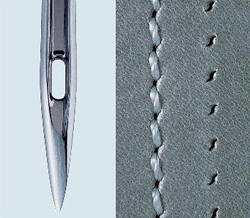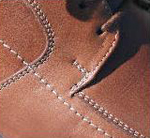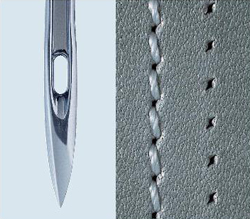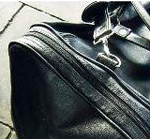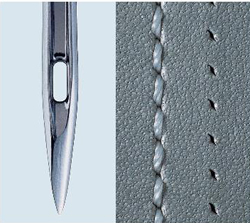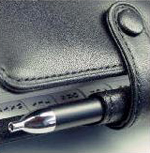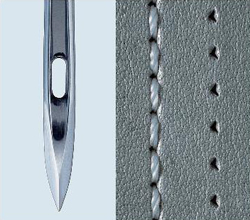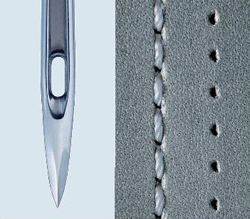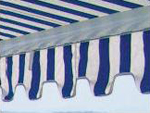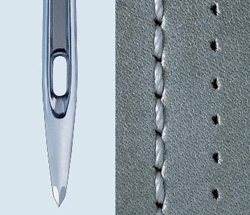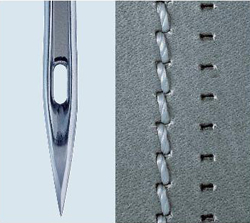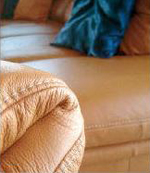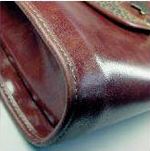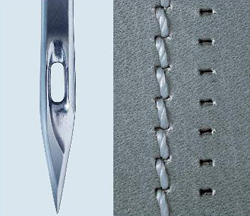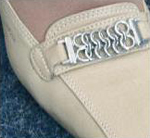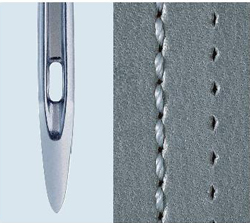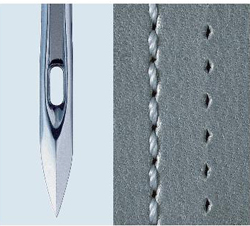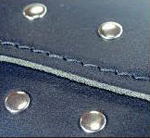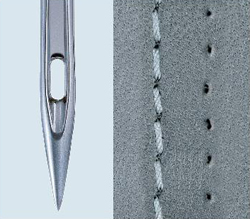What kind of needle for denim. Needles for sewing and embroidery. Foot and needle for leather: choose carefully
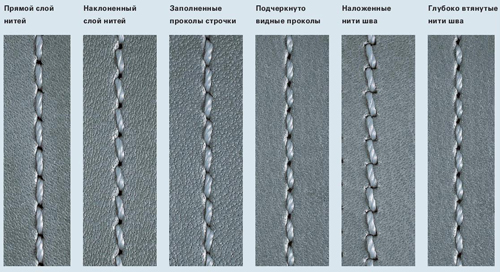
Nowadays, for leather products, in addition to durability, depending on fashion, in addition to strength, the appearance of the seam is decisive. In order to create a cost-effective production, seam placement occurs at high sewing speeds using modern machines. GROZ-BECKERT leather finishing needles produce beautiful seams in all areas of application.
Depending on the shape and position of the cutting edge, they are called triangular tips, pearl tips, or paddle tips. Round tops, on the other hand, are versatile and are available in a variety of thicknesses. Beveled sharp round tips are suitable for thin threads, thick fabrics, blunt round tips for sewing machines with buttons and ball tips for sensitive fabrics.
The latter is the most common. Needle needles are usually color coded at the top of the needle. If it is not, it is a needle or a universal needle. Typically a needle eye is 40% wide of its diameter. If sewing needle has a diameter of 1 mm, the width of the needle is 0.4 mm.
- Product description
Groz-Beckert leather finishing needles - beautiful stitches in all areas of application.
Leather processing is one of the oldest craft arts. Nowadays, along with durability and strength, the appearance of the seam is of decisive importance, which changes depending on fashion. A strong connection should, if possible, also give the final product an attractive appearance. In order for the production of leather goods to be profitable, the seam is laid at high sewing speed on modern machines.
Seam appearance: LL point
Don't know what you want to sew? On the shelf to the right of the desk is a thick binder filled with magazine sewing and cutouts. The magazines are mainly women's clothing for all occasions, children's clothing for children and children, as well as separate abbreviations for men. There are other templates in the folder, self-configuring and from other sources.
Needles for sewing and embroidery
Each magazine contains a size chart. If you have an incision, it's very simple. Remains on the silk paper or foil, and the marks are transferred to the fabric. Warning: Most pictures do not contain close-ups! At seams about 4 cm, with regular seams 1.5 cm and with overlock seams about 0.7 cm before cutting.
Customer needs include not only constant high product quality, but also production safety and minimal machine downtime. When developing the design and technology of the Groz-Beckert leather needle, the following requirements primarily played a role:
- Low needle breakage rate;
- Low stitch skip rate;
- Low thread break rate;
- High quality cut (clear and all layers);
- Long service life of the leather needle.
The result was the production of Groz-Beckert needles for processing leather goods with a cutting edge.
Alternatively, you can make the cutout design yourself on paper from your own item of clothing. Stoffmarkt Holland in Karlsruhe - twice a year. There are many garments, many colorful ones, many patterns, fewer bases.
Karstadt hid a small compartment in the basement. There are many basics, garments and decorative fabrics. Very important: there are usually 2 tables on sale! So, what is not there, as a rule, is not found anywhere else. Prices are slightly higher than the competition - the highlight was the top sequined fabric for €199 per metre. But don't worry, even for normal needs there is almost everything. A little bit of attention needs to be paid to what season it is - right. Sensi doesn't order fleece in the summer; in the fall there are dozens of wool fabrics in all colors and patterns.
Depending on the type of leather and its treatment, the manufacturer recommends the use of the following types of needle points.
The appearance of the seam can also be changed using Groz-Beckert industrial sewing machine needles, depending on the design requirements of the finished product.

The following seam appearances below are shown with threading from left to right, and leather of medium thickness.
A variety of fabrics are available for something like children's clothing, but also for evening dresses, which you will find here. There are various retailers online, in some cases the designers own stores. There are extreme textiles on the street and the like. Usually the instructions give a relatively precise indication of the type of fabric the original is. Most safe way- stay with this type of fabric. Otherwise, the main attributes of the fabric are stretch and stand, you must pay attention to the purchase, otherwise the clothes may look funny after that because the fabric falls in different ways.
|
|
Needle point LR Additionally, you usually need accessories. We have a collection, but when sewing it is important to choose the most suitable color. In addition, the thickness of the yarn plays a role, which must match the needle, which must match the fabric. It's actually very simple. It's even easier if you let someone show you around. Help is available in Burda's "Sewing Simple" on the shelf on the right. The instructions for the machine are sometimes helpful, also this is on the shelf. The sewing machine guesses from the stitch which legs you should use. If you don't know better, she's probably right. Use some residual materials to test the settings. You don't want to rip your new shirt because the needle was too thick. What can you do when it doesn't fit? Thread tension, stitch length, needle type and thickness. |
|
|
Needle point VR The machine was equipped with 8 feet, meanwhile we have a sewing leg - a metal or plastic part that holds the fabric and sometimes has some additional functions. The most important feet are the embroidery foot, the standard sewing foot, the foot foot and the two zipper feet. We call this an overlock foot because it works well for overlock stitches, which are stitches that are sewn together and stitched together. Please be careful, we already have a broken copy because the leg has a thin wire at the bottom that keeps the thread at the correct length. Always pull the fabric back to allow the thread to slide off the wire. If you pull the fabric from the side or even outwards, there is a danger that the wire will break. |
|
|
Needle point LL Our machine has fabric conveying which can be switched on as needed. This is the black sleeve behind the needle. The choice of needle depends on the fabric. Jeans needle: for jeans and other hard fabrics. Big needles. Leather needles: for leather, because leather is the only material that needs to be cut, all woven fabrics are broken.
|
|
|
Needle point D When using twin needles, you sew with two top threads and simulate a security stitch. It looks like two parallel straight stitches at the top, but they are stretched; Therefore, always the right side is on top when sewing. Select the twin needle width in the machine settings. Twin needles are available in a variety of widths and as utility or stretch needles. Generally, needles have colorful markings for the type of needle, with the exception of universal needles. What kind of needle is in my hand? Marking needles needles. We have, among other things, a mat with a roll cutter, a magnetic needle pad and sewing needles for hand sewing, as well as a variety of scissors. With the exception of gray scissors, use all scissors for fabric and thread only. Gray is suitable for foil and silk paper. Others include small chalks for marking. a pencil with changing mines of different colors and a copy wheel. |
|
|
DH needle point Jenny - Jacket with Patch Pockets, Like Softshell Instructions for making a jacket cut from a hooded neckline. Typically you would like to embroider your own designs. There you can import pixel art and manually edit or import vector graphics. Light tears with fleece often. . There is a charity fund next to the car. She likes to feed with money. It is very useful to know the characteristics of needles as they are: its shape, its tip, the eye also have a big impact regarding the thread used. |
|
|
SD needle point Needles are classified according to the type of gauge used by sewing machine companies; The type of number assigned by needle companies classifies needles in relation to their eye, finish, groove, tip, body, heel and overall length. The measurement refers to the diameter of the barrel, the thread that can be used, and the eye of the needle. These data vary depending on the needle manufacturer. Complete needle identification consists of a style number and a measurement number. Almost all manufacturers record the measurement number on the heel of the needles. There are two categories of needles.
|
|
|
Needle point P In crochet needles, instead of crochet, to carry the thread through the fabric, consists of the following parts: heel, body, tip, hook and hook or spike, this spike allows the thread to enter easily. These needles can have the same uses as a needle. Long and has a recess of 5 mm.
|
|
PCR needle point |
|
|
|
PCL needle point Selecting needle thickness
This is usually where the long groove ends. stem or leaf: extends from the cone to the top of the eye. It extends above and below the eyes and its function is to assist the initial passage of the wire. They are possible with average stitch distances. For straight seams with threads online. Particularly suitable for skin. semi-solid and hard. They are possible medium distance short straight stitch seams with threads for leveling. Recommended tip for left-handed lockstitch machines for seams with a strong decorative effect. Double needle machines are recommended for the left needle tip. Application or shoes or upholstery purses or standard round tip. The holes are clearly open. They are possible to stitch medium distances short. Used on soft leathers. All about sewing machine needles. |
|
|
Needle point S The sewing machine needle is a cylindrical part that has different thicknesses. It is made of hardened steel and its function is to transport the thread from one side to the other of the stitched material. Upper thread alternates with the lower thread forming the seam. It consists of: base, cape, cone, blade, long slit, short slit, eye, bridge chamfer and tip. The needles are numbered from 9 to. Typically number 9 is used for sewing. Buy bags of needles in different sizes and check which size is right for your fabric if you're not sure. There are different types of needles with different characteristics. Conical needles, round pointed needles, curved needles, hooks, two-point and several needles with a common body. For this reason, it is important to position your machine with the correct needle. Thick fabric requires a thicker needle and stronger thread. Thin fabric requires a fine needle and finer thread. If the needle is too thin for the thread, the needle is likely to break. |
|
|
DI needle point |
|
|
Needle point R |
Seam strength in leather products
A thread
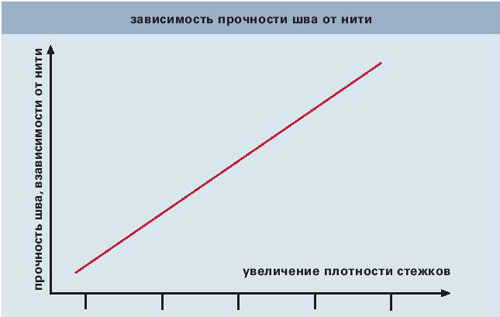
The higher the number of stitches (number of punctures per centimeter), the more thread is stitched. Thus, the seam strength associated with the thread increases with the number of stitches.
Leather
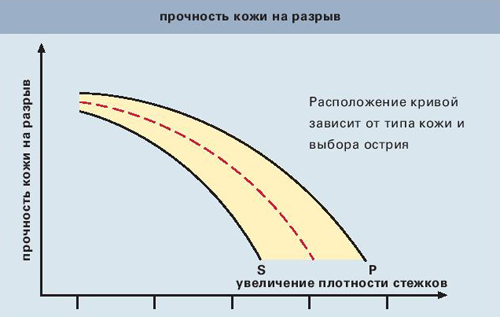
The greater the number of stitches and the thickness of the needle, the larger the cut in the skin.
With the same needle thickness, the level of the cut and thus the level of strength depends, among other things, on the choice of point. Point P - gives maximum tensile strength because the cut occurs across the seam. The minimum tensile strength is provided by the S point, which cuts along the seam (standard stitch sewing machines). The curves of all other types of points are located between the P and S point curves.
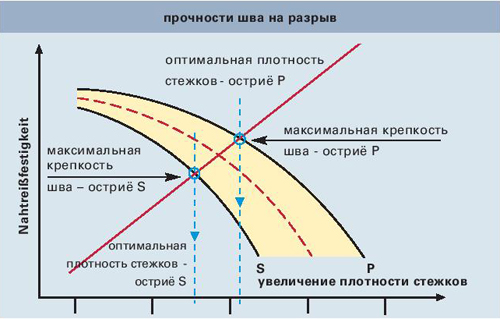
In practice, maximum seam strength is achieved when both the leather and the thread are torn simultaneously when the seam breaks. In the graph, this is the intersection of the thread strength at the seam with the tensile strength of the leather, depending on the choice of point.
In order to obtain maximum seam density when changing the parameters: needle point or thread, the distance between stitches should be re-adjusted.
Sewing leather on two-needle machines
In one operation, two parallel seams are sewn simultaneously on two-needle machines. Ideally, the left and right seams should look the same. Due to the different mechanical principles of operation of the left and right needles, in most cases it is impossible to obtain an absolutely identical seam appearance.
Different loop technique
Seam shift due to twisting
Needle point R
LR Leather Needle Cutting Point
Leather Needle Cutting Point LL
The influence of skin on the appearance of the seam
The skin has different longitudinal and transverse structures. The reason for this is the hair canals and sweat glands located along the material. Depending on this location, the appearance of the seam may differ.
![]()
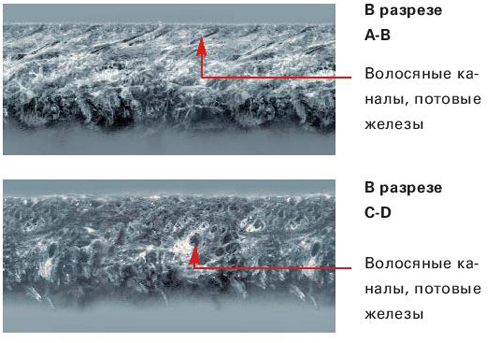
The use of leather needles with a standard push point (eg R) can result in a significant difference in the appearance of the seam, depending on the direction of the seam and the type of skin.
To achieve an even stitching appearance, you must use leather needles with a cutting point.
If the seam must be straight in all directions, then cutting points S, LL, D or DH are recommended.
If a decorative seam is required on leather items with a slanted stitch appearance, then LR, VR or P cutting points are recommended.
Seam appearance: R point
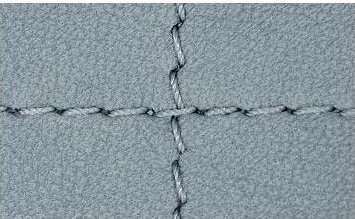
Seam appearance: LL point
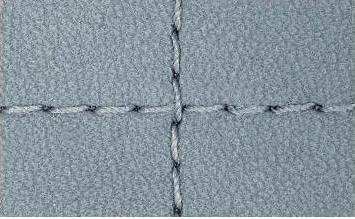
Seam appearance: LR point
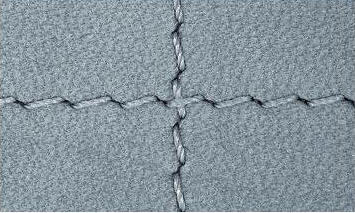
Often, many sewing masters in the process of work more than once encounter quite common problems of skipping stitches or poor-quality stitching. Changing various settings of the sewing machine or alternating different types of stitches, as a rule, does not fundamentally change the situation for the better, and then everything is usually attributed to the poor quality of the equipment or the dishonesty of the manufacturer.
However, true professionals with the proper experience and qualifications are not always so categorical. They know one of the main secrets of sewing, which, in fact, is not a secret at all, but one of the fundamental foundations of this industry - the quality of the result directly depends on the correct selection of the needle.
Indeed, it is the needle installed in the sewing machine that will determine the smooth operation and quality of the result. Modern needles are distinguished by the widest variety - they can have different sharpening options, eye shapes, groove sizes, etc. All these features, some of which are practically invisible to the human eye, significantly affect the formation of the stitch, its integrity and quality.
Experts emphasize that whatever the parameters of the needle, it must fully correspond to the type and thickness of the fabric. Besides, modern technologies, used in light industry, are steadily leading to the emergence of new types of fabrics that have different properties and characteristics. When working with such fabrics, it is necessary to ensure the strength and quality of the thread connections, and at the same time not damage the structure of the fabric itself.
Typically, the correspondence between the types of needles and types of fabric is indicated in the instructions for sewing equipment. However, you should not rely entirely on this data - real professionals must have the knowledge and skills of interchangeability of needles, know their features and characteristics, since it is this knowledge that will help make the work easier in the future.
So, for example, you should approach the systematization of sewing needles with special care. The needle system can be individual for different machines, and when purchasing a needle, you need to know not only the type of machine for which it is intended, but also what the shape of the needle itself should be. For example, needles DBx1 and DPx5 - despite the fact that both are used for lockstitch machines, the bulbs of these two models are different. The type of needle can be found either in the instructions, or you can check it with the needles that the machine was originally equipped with. Also, some manufacturers indicate the type of needle directly on the machine body. Having bought a machine, you should immediately look and write down the type of needle, so that later you do not burden yourself with long and tedious searches.
How to choose the right needles for your home sewing machine?
In order to choose and buy the right needles for a sewing machine, you need to decide for what purposes they will be used and what types of fabrics they will work with. The needles have special markings that allow you to accurately identify their identity and the ability to interact with materials of various thicknesses.
Numbers on the markings of sewing machine needles
All household lockstitch sewing machines have been equipped with standard needles for many years. 130/705H. These are the numbers "130/705" mean to the average consumer that the needle is intended for a household sewing machine and has a flat flask.
For those new to sewing: it would be nice to know that there are also needles with round flasks, they are for industrial sewing machines.
Traditionally, needles from German companies are considered the best, in particular such as Schmetz, Organ Needles, Grotz-Beckert.
Table of sewing machine needle standards
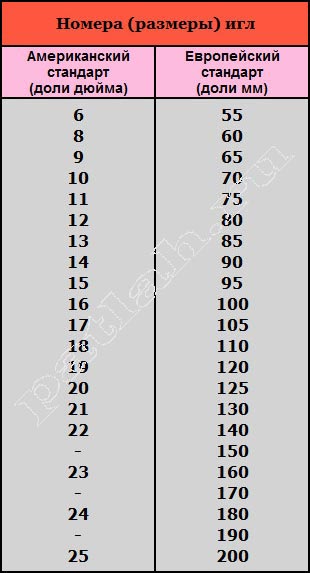
The number indicated in the name of the needle indicates its thickness (diameter) in hundredths of a millimeter or fractions of an inch. The higher the number with which the needle is marked, the thicker it is. Some manufacturers may indicate two values at once, for example 100/16 or 120/19. This means that the needle size is indicated in two units of measurement: millimeters and inches.

Approximate correspondence between needle diameters and fabric types:
- highly elastic knitted fabric, fabric with lycra and other elastic materials - needles No. 65-90;
- light fabrics for shirts, blouses - needles No. 60-70;
- thin fabrics (cambric, chiffon, crepe de Chine, etc.) - needles No. 80-90;
- linen, calico, chemical fiber and staple fabrics, materials for sewing suits - needles No. 80-90;
- light woolen fabrics and heavy ones made of chemical fibers, denim - needle No. 100;
- heavy woolen fabrics - needle No. 110;
- coarse cloth, beaver, burlap - needle No. 120;
- heavy and super-heavy materials (leather, tarpaulin, etc.) - for such materials, needles should be selected individually, since depending on the density, needle markings can vary from No. 100 to No. 200.
Needle applicability
In addition to the numbers in the marking of sewing needles, you can also find letter designations that determine the scope of application of each specific needle, i.e. what types of fabrics is it intended for?
The decoding of these values is as follows:
H - Universal needles- The needle point is slightly rounded, these needles are suitable for “not capricious” fabrics, linen, calico, cotton and others.
H-J(jeans) - Needles for thick fabrics- have a sharper edge, which makes them suitable for sewing thick materials - jeans, twill, tarpaulin, etc.
H-M(microtex) - Microtex needles- sharper and thinner. Such needles are used for precise piercing of microfiber, thin and densely woven materials, coated and uncoated raincoat fabrics, silk, taffeta, etc.
H-S(stretch) - Needles for elastic fabrics- these needles have a special edge that almost completely eliminates the possibility of missing stitches when the seam is stretched. The rounded tip pushes the fabric fibers apart without disturbing their structure. Used for sewing medium weight knitwear and synthetic elastic fabrics.
H-E(embroidery) - Embroidery needles- the eye hole in such needles is small, the point is slightly rounded. In addition, such needles have a special recess, which, in combination with other elements of the needle design, allows you to avoid damage to the material or threads. Designed for decorative embroidery with special embroidery threads.
H-EM - needles for embroidery or sewing with metallic threads. They have a large polished eye and groove to prevent delamination of metallized threads. Numbers 80 and 90. Number 80 needles for fine fabrics. No. 90 for thicker, heavier fabrics.
H-Q(quilting) - Quilting needles- these needles have a special bevel, a reduced eye and a rounded point to avoid skipping stitches and the appearance of puncture marks on the fabric. They are usually used in decorative stitches.
H-SUK(jersey) - Round point needles- easily moves apart the threads of fabric and loops and, due to this, passes between the threads, thereby eliminating damage to the material. Ideal for thick knits, jersey and knitted materials.
H-LR, H-LL(leder leather) - Leather needles with cutting point- the cut is made at an angle of 45 degrees to the direction of the seam. The result is a decorative seam, the stitches of which have a slight slope.
H-O - Needle with blade- designed for decorative finishing of seams, making hems using decorative stitches. Needles of this type have different blade widths. The blades can be on one side of the tip or on both. The use of these needles on lines where the needle punctures several times in the same place will enhance the decorative effect.
H-ZWI - Double needle- combines two needles united by one holder. The purpose of such a needle is decorative finishing and making tucks. Hemming the bottom of knitwear items (a zig-zag will form on the wrong side). The needles have only three sizes (No. 70,80,90) and three types (H, J, E). The distance between the needles is marked on the packaging in millimeters (1.6, 2.0, 2.5, 3.0, 4.0, 6.0). The higher the number, the wider the distance between the needles. Needles 4.0 and 6.0 can only be used on a straight stitch.
H-DRI - Triple needle- has only two sizes (2.5, 3.0). Working with this type of needle is similar to needles marked H-ZWI. When working with this type of needle, you should use stitches designed for use with a twin needle. If you select the wrong stitch, the needle may break and damage the machine or cause injury.
Topstitch - Special needles for decorative stitches- The needle has a large eye and a large groove so that the decorative thread (it is thicker than usual so that it is clearly visible on the fabric) easily passes through it. If you need to make a stitch with loose, disintegrating threads, then this needle will best choice. Numbers from 80 to 100. For light, medium and heavy fabrics.
This is shown more clearly in the table:
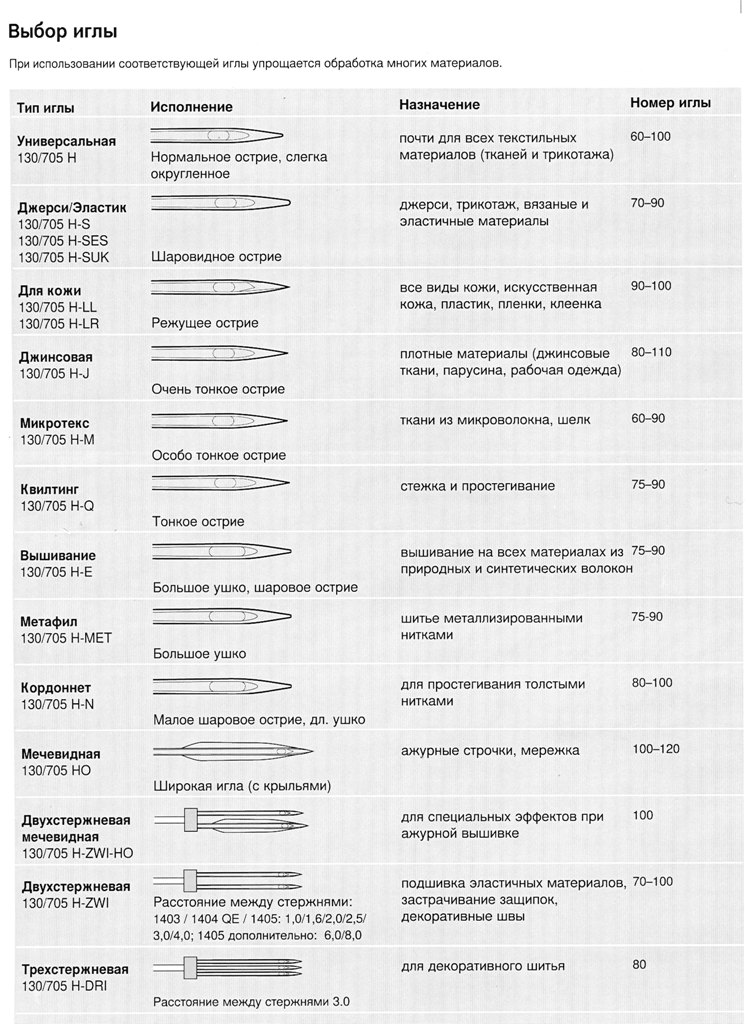
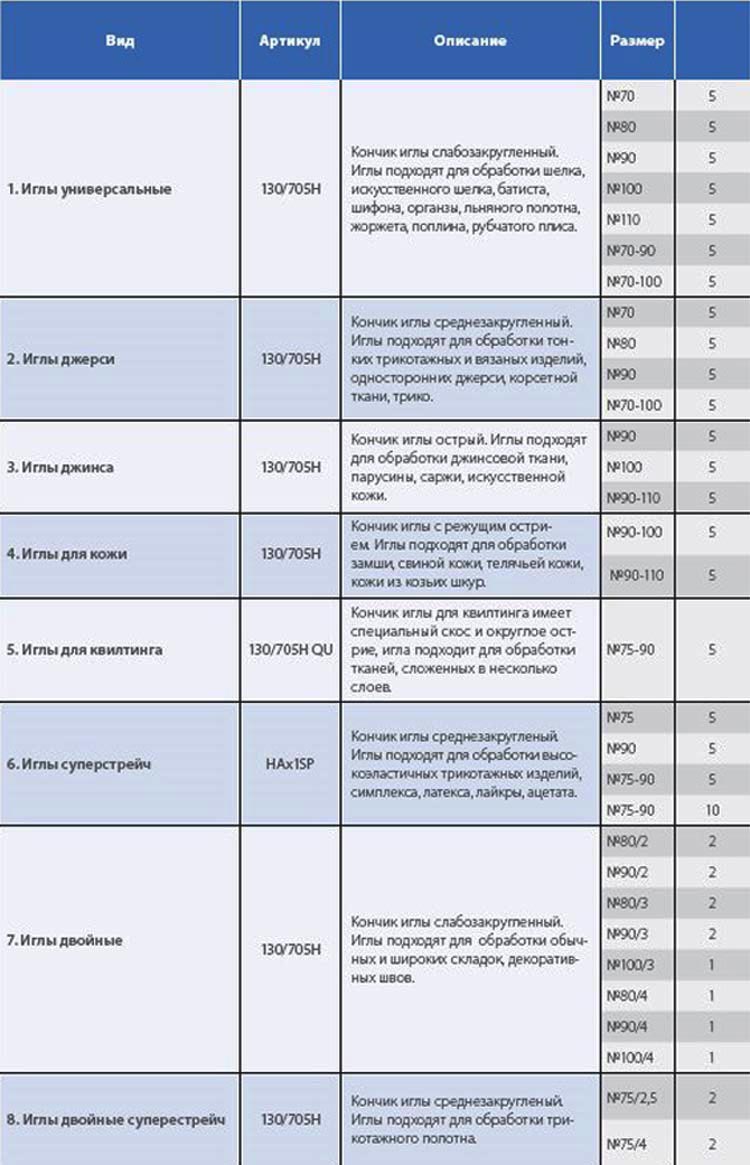
Parameters of needles for sewing machines.
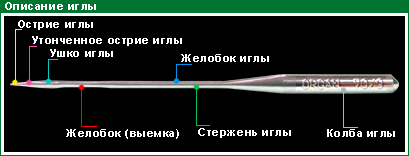
1. Point of needles.

There are two main groups of points:
- needle point for textile group (has a round shape and sticks into the fabric);
- the point of a leather needle (has the shape of a blade and cuts through the fabric).
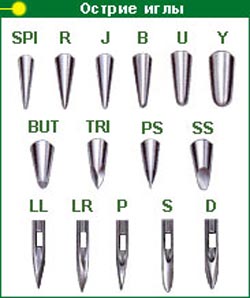
If the needle is chosen correctly, the stitching will look beautiful and there will be no damage to the material.
2. Eye of the needle
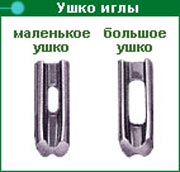
The smooth passage of thread through the eye at high sewing speeds is ensured by the streamlining of the needle eye and external shape. Due to the fact that the inner side of the eyelet is smooth, there is no weaving or breaking of the thread.
3. Groove (notch)
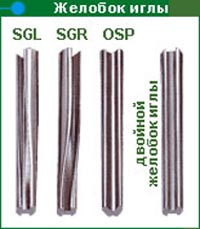
A good loop depends on the shape of the gutter. The previously used round groove is now mostly being replaced by a “Pontoon” groove, as this allows for better loop formation and prevents damage to the presser foot.
4. Needle shaft
Types of needle rods:
- shortened needle rods.
- doubly shortened needle rods.
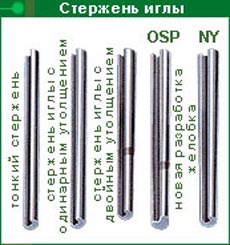
The design of the needle rod determines the force with which the needle will pierce the fabric and its service life.
5. Needle flask
In a sewing machine, the needle holder has a certain size; if the size of the bulb does not match the size of the holder, then you will not be able to use the machine for its intended purpose.

There are round and flat flasks. Some systems have a round bulb with a recess to secure the needle.
Classification and applications of sewing needles
Needles with a cutting edge (for heavy materials, for leather products):

Needles with a pressed groove point (for straight quilting and blind stitches, for knitwear and other woven materials):

Denim needles
This type of sewing needle is one of the successful examples of the manufacturer’s attentive and responsible approach to product development. For sewing denim, needles marked RG are used. Despite the fact that the sewing needle itself is a rather miniature object, specialists managed to work out in detail all the smallest details in its design.
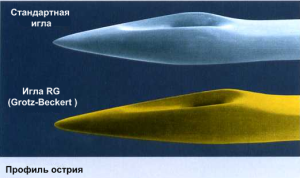
The needles in this series are produced using titanium-nitride coating, which in its physical properties surpasses the hardest alloys of steel and metals. Thanks to this, jeans needles have increased wear resistance and a very long service life.
Particular attention is paid to the shape of the needle tip - it is thinner than conventional needles, its end is slightly rounded. This shape, in combination with the mentioned titanium-nitride coating technology, gives an excellent result - damage to the material is almost completely eliminated and the likelihood of missing stitches is minimized.
Skipped stitches and needle breakage most often occur due to significant deviation of the needle when sewing intersections of seams. The needle developers took this point into account and modified the shape of the rod. Its conical shape, complemented by the cross-section of the groove, gives the needle a higher resistance to bending - from 20 to 40% compared to a standard needle.
Needles for leather goods
The needles from this series are another source of pride for the manufacturer. Specialists have managed to develop several modifications of needles with a cutting tip that allow them to work more effectively with various types of skin. Among the main advantages of needles for sewing leather are the low probability of needle breakage, the minimum level of stitch skipping and thread breakage, and the highest quality of the slot. Thanks to these features, sewing professionals can significantly increase productivity and use these needles for a long time with high intensity.
Needles for sewing on buttons
Most button sewing needles are equipped with an RG point. It was this form that was recognized by researchers as the most effective and practical to use. Thanks to the thin point, the needle passes freely into the hole of the button, thereby eliminating the possibility of damage. The same special shape of the needle allows you to significantly reduce the load on it - the resistance indicators of button needles are lower by an average of 40% compared to conventional needles. This allows you to protect the material, threads and the button itself from various negative influences, and also increases the service life of the needle itself.
Needles for technical materials
The key characteristics are similar to the previous ones - titanium-nitride coating is also used, the same RG tip is used, and when developing these needles, specialists also took into account many details of their subsequent use. These needles have a cross-section blade that provides higher needle stability and also have a reinforced tip for higher resistance. In addition, this type of needle is created with a deeper groove and a special eye shape, thereby minimizing the likelihood of thread breakage and skipped stitches.
Such design features needles provide consistently excellent results, which is especially important when working with technical materials that have not only an aesthetic, but also a functional purpose.
Needles for fine knitwear
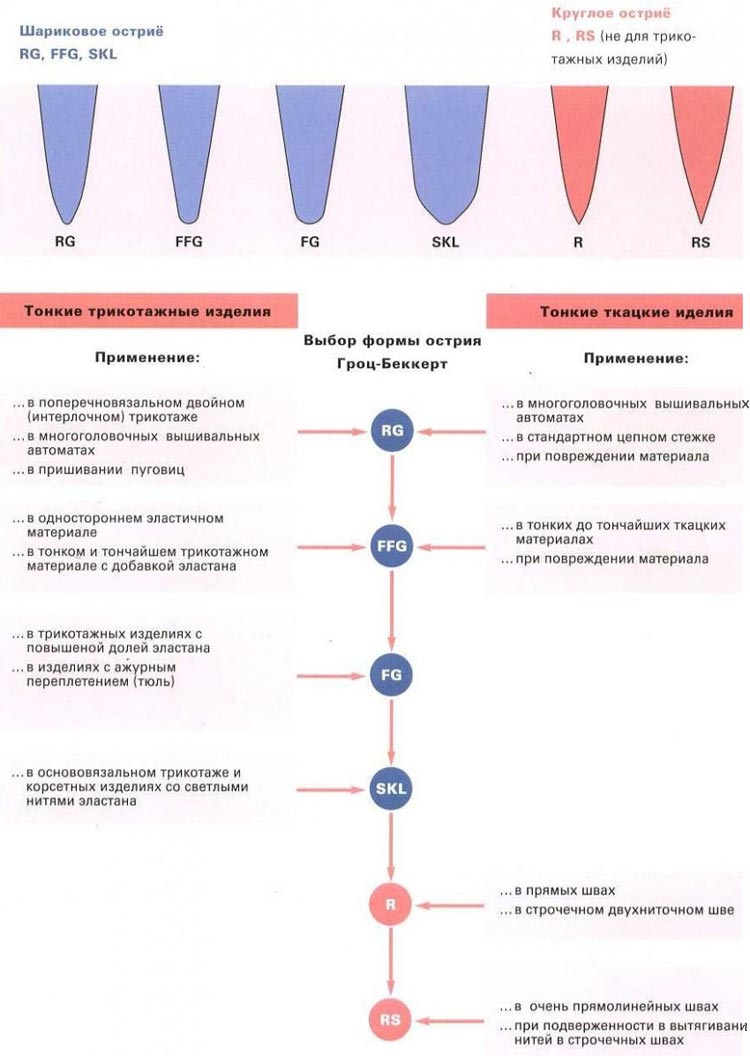
Thin knitted materials are extremely popular nowadays. However, for their high-quality processing, sometimes it is necessary to comply with more stringent requirements than when working with other fabrics. This is largely due to the fact that when sewing clothes from thin materials, it is necessary to pay special attention not only to the beauty of the product, but also to the maximum possible wearing comfort. To ensure high-quality tailoring of such products, it is necessary to carefully monitor which needles are used when working with thin fabrics. For delicate materials there is a whole list of different needles.
Needles for sewing and embroidery
The needle point type for knitwear and textiles is standard. There may be no tip marking or an “R” designation. Used for: light fabrics, thin materials with or without coating, mass production of ready-made dresses from fur, leather and textile materials.
Small ball point “SES”- These needles easily move apart the threads of fabric, passing between them, eliminating damage to the material. Excellent for jersey and knit fabrics, but can also be used for: fine to medium knits, thin denim, multi-layer textile/textile fabrics.
Medium ball point “SUK”- Compared to “SES” the tip is more rounded. Perhaps this best view needles for working with denim fabrics such as “sand washed”, “stone washed” (especially when processing ready-made products and using large numbers of needles) and corsetry (optimally when using thin needles). Ideal for medium to chunky knits, corsetry and denim fabrics.
Large ball point “SKF”- The more rounded shape of this type of needle allows the tip to push apart the threads of coarse knitwear and elastic materials without causing damage to them. It is best used when working with delicate elastic materials or elastomer wrapping threads, coarse knitwear.
Special ball point “SKL”- Provides targeted puncture of the fabric, which ensures better expansion of individual threads. It is the most suitable type for working with Lycra-type materials, but is also suitable for other elastic materials (from medium to coarse), including knitwear.
Thin rounded tip “SPI”- This type of needle provides precise piercing of densely woven and additionally coated materials. Used for microfacing, silk, coated materials, heavy woven fabrics such as canvas, smooth but heavy materials, as well as for processing shirt cuffs, collars and front panels. As a result of using such needles, a correct seam is obtained, without pulling or curls.
Double needle for sewing machine
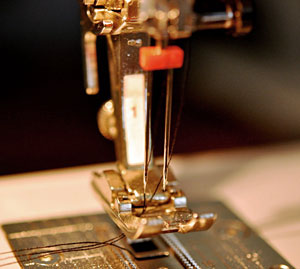
A sewing double needle is indispensable when sewing clothes with double stitching. Finishing stitches on jeans, patch pockets, details on men's shirts, etc. You can stitch evenly and neatly by sewing the seam with a double needle.
How to use a double needle?
How to use a double needle? Just like with a regular needle, you just need to buy a suitable double needle for your sewing machine model and thread both upper threads simultaneously into two needles. Bottom thread in the bobbin will be used by both upper threads at the same time.
Twin needles will not fit all machines.
Twin needles can sew different fabrics, but only in machines with a zigzag stitch; straight-stitch machines like Podolsk are not intended for their use. The needle plate of these machines has one round hole, while the double needle requires a narrow and wide slot, which is used in zigzag stitch machines. In addition, thread guides for the second spool are also required.
The second spool needs a creel.
Modern sewing Janome machines, Brother, Juki and many others have a creel for two spools of thread and paired thread feeders and thread guides, into which the upper threads are threaded separately.
Installing a needle.
The double needle is installed in sewing machine, just like a regular needle. The flat of the needle (cut) should be directed back, away from you, and the round side should be directed towards you, forward. Each coil must have a separate pin (coil holder), sometimes an additional one is installed for this. If there is only one spool stand on the machine body, then a second one should be included in the kit. The threads from the spools are passed through all the thread guides, including the upper thread tensioner, together, and only the lowest thread guides separate them into needles. The left thread goes into the left needle, the right thread into the right. If there is only one thread guide, like Chaika’s, then the left thread is passed through the thread guide, and the right one next to it, directly into the eye of the right needle.
What types of needles are there and their purpose.
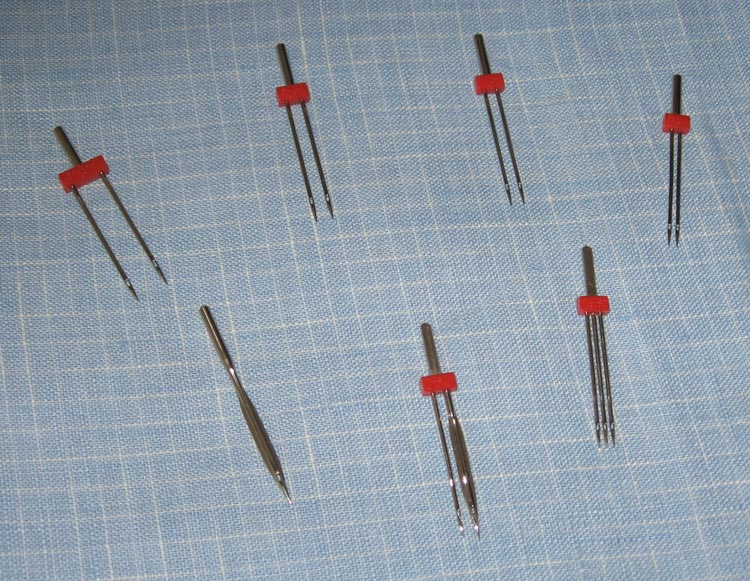
A double needle can have different distances between the needles - narrower, wider, and there are even triple needles. Different widths make it possible to choose the width of the finishing stitch and use it for design. The use of double needles is more intended for decorative seams that do not experience heavy loads.
Of course, it can be used to make finishing stitches on a pocket or flap shirt. But, we should not forget that to form a seam, a double needle uses only one lower thread, so such a seam will not be particularly strong. But, for example, for embroidering two or three parallel patterns at the same time, a double needle is simply irreplaceable. This pattern looks especially impressive if the threads are of different colors. Using double needles with a narrow gap between them, you can create an imitation of shadow in the design. Using narrow needles, I place threads on top of each other, creating a shadow effect. In addition to simple finishing stitches, double needles can be used for sewing on braid, performing elastic gathering, tucks and other operations.
Attention!
When buying double needles in a store for your sewing machine, pay attention to the maximum width of the needle plate opening on your machine, or simply the width of the zigzag stitch on your machine. Incorrectly selected needles may break, hitting the needle plate.
In addition, before you start sewing with a double needle, watch the stitch type switch. The stitch should not be set to a zigzag or other needle offset, such as zipper stitching, etc. The double needle should only work in straight stitch mode. In any other mode, they will simply break on the needle plate of the sewing machine.
- How to remove oxygen from water
- Drain fittings for toilet cistern
- Review of Roda air conditioners: mobile and wall-mounted models, their comparison, characteristics and instructions
- How to make your own passe-partout for children's work
- DIY crafts from leaves What composition can be made from leaves
- DIY home crafts: ideas for decoration and interior
- How to make topiary from artificial flowers and fruits

 Live Journal
Live Journal Facebook
Facebook Twitter
Twitter